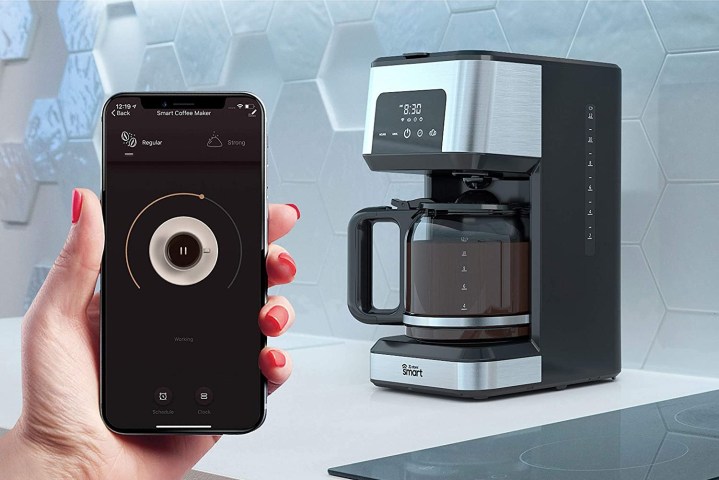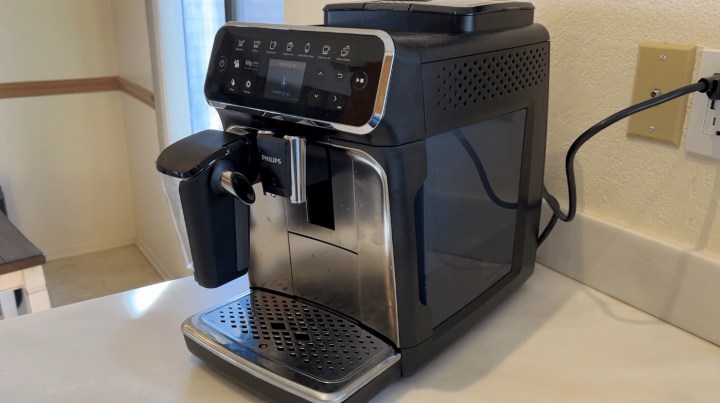Coffee gets a lot of us going in the morning. Whether it’s the comforting warmth, that jolt of bitterness, or — let’s be honest — the caffeine, coffee is the fuel that starts our engines each day. Coffee has evolved from its primitive origins as berries we chewed on, to the simple automatic coffee makers of the mid-century, and now today to fully automatic machines that can take care of every function for us — and some even have Alexa voice assistance built-in.
But do we really need all this technology in our morning cuppa?
How did we get to smart coffee machines?

Coffee’s origin story is well told: A young goat-herder was tending his kids and noticed they seemed to get quite excited after nibbling on the berries of a certain bush. Being the curious type, the herder sampled them himself and was hooked on the spike these small bitter berries seemed to provide.
Eventually, humans started cultivating these berries; we learned about roasting coffee and found better methods for crushing the roasted and dried beans. But, oh, all that labor! The automatic coffee machine made morning pour-overs was a thing of the past, at least until the youth of the 21st century rediscovered the joys of analog coffee methods. Many of us, however, want to save time and get to the sipping quicker and with less fuss. That’s where new coffee technology comes in.
Super automatic espresso machines
Anyone who’s ever extracted their own espresso using a manual machine knows this is truly an art form. The precision of the grind, the perfect tamping of the grounds, the pressure of the water, the water temperature, and even ambient humidity can all affect what ends up in your cup. That’s why the super automatic espresso machine was developed.
A super automatic espresso machine handles all of these tasks for you. With one press of a button it will grind your beans to your exact specifications, tamp them and extract the espresso into your cup. Most super automatic machines also have built-in milk heating and frothing too. Your contribution to this technology is pouring your favorite beans into the hopper and pressing that button.
Is coffee technology worth it?

The efficiency, speed, and quality of the super automatic espresso machine shouldn’t be understated, though it does come at a substantial cost. Super automatic espresso machines can start at just under a thousand dollars, and paying 2 or even 3 thousand for a brand name version is par for the course. But is it worth it?
I recently had the opportunity to try a couple of different super automatic espresso machines from both Philips and Jura. There is no denying the ease and convenience of these countertop behemoths. Yes, they do tend to take up a large footprint (but truthfully not much larger than your automatic drip coffee machine and grinder combined do). Waking up tired, bleary-eyed and in semi-darkness, it is an absolute luxury not to have to pull out the beans, spill a few on the floor, grind them, spill some of that on the floor, and then try to press out a quality espresso at 5:30 in the morning. Let’s not even get started on trying to properly froth the milk. There’s a reason coffee is sipped in the morning: It helps bring us from drowsy semi-consciousness to functional wakefulness.
These super automatic machines also make a variety of different beverages, meaning you’re not limited to espresso only; you can upgrade to a cappuccino or sip on an afternoon latte with the press of a button. No remembering measurements, grind specifics, or recipes. A super automatic espresso machine is definitely worth it, assuming you drink at least one or two espresso-based beverages a day.
Can I add Alexa or Google to my coffee routine?
Numerous coffee machine manufacturers are now starting to create coffee makers with Alexa voice control into their machines. Some might wonder … why?
This is the next logical progression of smart coffee: Why press that button at all? If you can ask your Alexa digital assistant in the bedroom to get your coffee going in the kitchen, by the time you arrive at the machine, your cup is ready. That’s some magic right there.

Keurig has been one of the early adopters of this technology with its pod-based machine. Through the Keurig Alexa Skill, you can ask
The trouble with some of these machines is that there’s still a significant burden on you to set your machine up for success. With a Keurig, you’d need to remember to add the pod ahead of time. Some of the machines can only turn on or off using voice control, while others offer more automation.
The Hamilton Beach Alexa coffee maker lets you ask
There are also ways to hack this set up with an existing coffee maker and a smart plug connected to Google or Alexa. These hacks tend to work best with machines that use a manual on-off switch, but this can be a more cost-effective way to add smarts to your coffee maker.
Even so, if you think about a drip coffee maker that’s Alexa- or Google-enabled, this might seem to make a bit less sense. You still need to get everything ready, add the filter, sprinkle in the grounds, and fill the water. Then you can ask Alexa to brew when you’re ready.
Is a smart coffee maker worth it?
It’s definitely a luxury to have barista-level brews made to order at home: Kind of like a java butler.
So is all this technology really necessary? In short, of course it’s not. Particularly with the resurgence of analogue coffee brewing methods, there are plenty of folks who find pleasure in their hands-on coffee routines.
But as someone who’s had numerous opportunities to review high-end automatic coffee and espresso machines, I can testify a smart automated coffee maker can save time, allow more consistency of brew, and (particularly with a super automatic machine) it can be wildly convenient. For those reasons I can highly recommend the experience. It’s definitely a luxury to have barista-level brews made to order at home: Kind of like a java butler.
The level of smart technology you want to add to your morning coffee routine is about your personal preferences, your morning routine, and how much you may or may not have your head together before you’ve had that first cup.
Let’s be honest, we can all cope with a manual coffee existence. When I remember to before going to bed, I am a big fan of getting my analogue drip coffee maker and my Nespresso machine set up the night before so I don’t need to find the dexterity (or my glasses) to keep from bumbling around the kitchen, since just this morning in my half-wakened state I knocked an entire bag of coffee beans all over the floor.
Good thing I was able to ask my robot vacuum to come and sweep it up.



